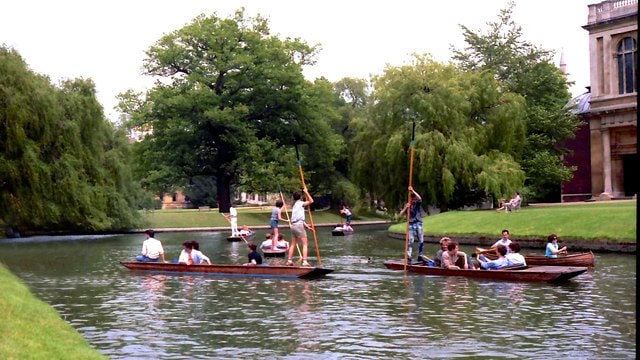Punting may seem like an Oxford institution. But it took John Anderzej Rivers, an Anglo-Pole Oxonian of the late pre-war period, to organise a yearly race down the northern stretch, later known as ‘the Piste’, of the river Cherwell (at that time pronounced Charwell). In 1913, he and two other young blades of Oxford, crossed the finishing line at Queens-Bank, becoming the first in a century-long line of punting victors. As one amongst them reportedly said of the occasion, “the air on the Cherwell that day was wet and heady with the joy of our victory.”
That man grew up to be none other than famous novelist Aldous Huxley, who presided over the next two summers of the competition, which is said to have inspired the pacifism of his later years. Even though the inchoate competition was ‘rough and ready’ with little formal structure, one could already see the core values which, in coming decades, would come to define the competition: goodfellowship, proper religion, and respect for the institution of private property.
The races continued each summer until the coming of the Second World War put something of a pall on proceedings. Yet even in those troubled days, the spirit of competition punting persevered, sustaining hopes and resolves, fanning the flames of aspiration, throughout ‘their darkest hour.’
The apocryphal tale of ‘Punting Peter’ emerged then, a junior officer who carried his old punting-pole from the beaches of Normandy all across France as a good-luck omen, before leading a last-ditch charge against the Nazis at the Battle of the Bulge. He died heroically, still holding on to it with both hands. Indeed, word even reached high command – General Montgomery once remarked, “an ounce of punting spirit is better than a pint of oil.”
The end of the war saw the arrival at Oxford of perhaps the most prestigious of punters – J. R. R. Tolkien. It is often claimed that punting was as natural to him as water to a duck: “his canny hands manipulated the pole as though they knew its every pleasure.” Tolkien won the races five times, and presided over them six times, leaving him by far the most accomplished punter before the advent of the modern competition. Who knows if the idyllic haven of the Shire was not inspired by the picturesque fields and dales of the Upper Cherwell?
Yet by the late fifties, punting in Oxford saw a slump – there are no recorded races for 1958 or 1959, leading some to speculate that the competition was discontinued, surely unlikely given the great favour it enjoyed before then. 1960, however, brought monumental changes to Oxford punting, ensuring its legacy as a quintessential university diversion, with the creation of the Royal Charter of Oxford Competition Punting, a document that remains the foundation of the modern competition to this day. The charter, obtained through the generous intercession of the Princess Alice, Duchess Gloucester, established the rules of the competition, enshrined its four core values of life, property, goodfellowship, and law, and mandated the victors be awarded with the golden image of a punt – the ‘Punting Cup’.
From the inauguration of the 1960 charter, the Punting Cup went from strength to strength, growing into a truly iconic Oxford event. The late 1970’s and early 1980’s were the heyday of the Punting Cup, with competitions routinely seeing over a hundred vessels competing in the opening seeds. It was a time of great optimism in the country at large, too – with the Oil Crisis and recession coming to an end, Britain was open for business, and there is no doubt that these high spirits affected the situation on the river.
This era saw the expansion of the trade in tourist punts, above all on the lower stretch of the Cherwell towards the Magdalen Eyot, which had become a popular alternative to the traditional Piste of the Upper Cherwell as the rolls of competitors filled up. A brief ban on competition punting in the early nineties, under the vice-chancellorship of Sir Richard Southwood saw the Punting Cup go underground for almost half a decade.
Yet official sanction could not quash Oxford’s appetite for the summer races: students would reportedly cycle up to the Piste from their colleges under cover of night, hiding bottles of gin and boxes of strawberries in their undergarments, and punt on ‘borrowed’ vessels. An entry from the 1991/1992 ledger describes the final for that year: “races went from Queens-Bank at midnight; Lincoln’s second vessel took the fifth seed with a gap of nine yards, and the Cup.”
Although the ban was swiftly annulled, the spirit of subversion and daring that flourished in those years lingered for ever after, immortalised in the proverbial watchwords of Oxford’s punters: “hot-blooded by temperament, risk-takers by disposition.”
In the early 2000s, the Punting Cup rebranded to Punting Cuppers, in line with the rest of the university’s inter-college sporting competitions. At the same time, reforms were made to the competition rules, notably the inclusion of a dedicated paddler to the required four-punter team. Paddling had not been a regular part of punting form for most of the competition’s history, often being thought of as a crutch for inexperienced crews; it was not until several speed records were broken in a row, that continuous paddling was recognised as key to success on the Piste.
This year has seen the largest first seed since 1978, a testament to the hard work of the committee in bringing Punting Cuppers into the Information Age. Over two hundred competitors entered the rolls, many enjoying their first ever taste of this timeless Oxford tradition. Looking to the future, who knows quite where the story of Oxford punting will sail next? For now, at any rate, it looks like yet another season of light, beauty, and goodfellowship on the Cherwell.



